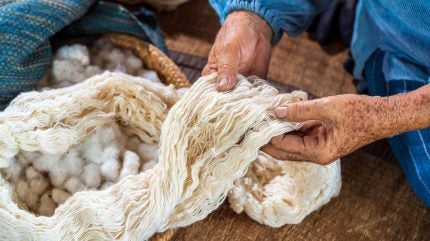
Material innovation is the intersection of technology and fashion when new materials and technologies create fabrics and clothing with enhanced properties, sustainability, and functionality. This encompasses an array of advancements, from sustainable textiles and smart fabrics to novel production methods.
The need for material innovation has become increasingly important given the fashion industry’s major carbon footprint is said to account for 8% of global pollution.
In line with the fashion industry’s agenda of making the industry more circular and sustainable, companies are exploring new materials.
At a recent panel discussion at the Future Fabric Expo, industry veterans explored the potential of material innovation and its incorporation in the larger value chain, describing it as a nascent field and sharing the scope of what more could be done.
The current landscape
Lacey Davidson, director of marketing and communication for the mycelium technology company Ecovative believes the field is “burgeoning with potential,” offering numerous solutions aimed at reducing the carbon footprint of fashion brands.
Davidson highlights it is important to note it is in the “early stages” and there’s ample room for a variety of players to contribute: “No single perfect solution exists, nor is it likely that one will emerge. Instead, the focus should be on the array of available options that collectively work towards sustainability, each solution is getting incrementally better every year.”
She sees the diversity of solutions in this space as an advantage, allowing brands to explore and adopt materials that align with their sustainability goals and production capabilities.
“It’s a really exciting time in the material innovation space right now,” adds Roni Gamzon, co-founder and chief commercial officer (CCO) at fashion tech startup, BioFluff. “There have never been so many innovations on the market that are ready for scaling. Development of these materials is accelerating with product quality and offer increasing at a fast rate for getting them ready for market.”
Amy Tsang, head of Europe at Hong Kong-based technology incubator The Mills Fabrica, on the other hand, notes there’s a significant shift towards bio-based materials, recycling technologies, and innovations that reduce resource consumption and waste.
However, she emphasises that to make a greater impact, these practices need to be adopted at a larger scale and not just on the brand side, which she claims are already embracing it.
Raw material availability, complexities in the supply chain
One of the major drivers for Ecovative is being able to use an abundance of materials. Davidson explains the mycelium they use is grown in existing mushroom farms which allows for “seamless” integration into current supply chains.
This not only simplifies the process but she points out it also provides mushroom farmers with a high-value new crop which they are eager to cultivate.
By leveraging existing facilities and expertise, Ecovative avoids the need for new infrastructure or Capex investments and ensures an efficient and sustainable scaling process: “Our collaborative approach with established tanneries allows us to deliver high-quality, eco-friendly materials to the market without significant additional investments.”
According to Tsang, by focusing on this one solution that has multiple use cases, Ecovative has been able to produce a range of products from mushroom packaging to leather alternatives.
As for BioFluff, Gamzon explains the startup has created the world’s so-called “first” 100% plant-based alternative to animal fur, synthetic faux and almost all fluffy materials that are derived from animals or fossil fuels – all of this using 100% renewable plant fibres and agricultural waste.
Complexities and challenges
Davidson is quick to point out that “integrating” these innovations into an existing supply chain is a complex process which Ecovative has been refining for over five years through the development of its base technology, AirMycelium which was the result of significant trials and errors.
For BioFluff’s Gamzon, it is the expectation that new materials can instantly match the industry’s current preferred material: “It takes a real commitment and investment to drive impact – time to perfect the product, the costs will be higher to start with but as desire and orders increase, the price will come down to a more competitive level.”
But that is not it, Tsang outlines technical and distribution challenges, stating that companies must consider the durability and performance of new materials, and their compatibility with existing manufacturing processes.
“With this also comes a level of fear,” she notes, “as brands are concerned about lessening the quality and durability they are known for. Supply chain logistics must be adapted to source, process, and distribute these materials efficiently and sustainably.”
Role of partnerships and collaboration
Gamzon explains that at the current stage, partnerships have to be “considered and strategic” because these partners not only create an opportunity for visibility and scale but also play a crucial role in product and material development.
Echoing the same sentiments, Davidson remarks that successfully bringing new material to the fashion industry is based on three essential elements – having the right investors; willing brand partners and, a strong network.
She says: “At Ecovative, our Fashion For Good collaboration brought together a handful of fashion and footwear brands who agreed on the same material specifications and spent 18 to 24 months developing and testing materials. This collaborative effort was instrumental in scaling the material to a commercial level and bringing it to market.”
Tsang adds that partnerships and collaborations are central to advancing material innovation: “No man is an island, and only by fostering collaboration will we be able to successfully alter the fabric of the fashion industry.”
She views collaboration as a way to facilitate knowledge exchange, helping to address common challenges and push the boundaries of what is possible within the fashion sector with new sustainable materials.



